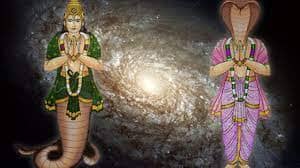
Rahu Grah And Ketu Grah Story - The Eight And Ninth Navagraha

Navagraha is the nine heavenly bodies and deities that influence human life on earth according to Hinduism and Hindu astrology. This article will narrate to you the various aspects and stories associated with the 8th and the 9th of the Navagraha Rahu and Ketu.
1. How Rahu and Ketu were Born
Unlike other Navagraha members who do not rule upon a physical planet, they are called Chhaya Graha, which means shadow planets, and are hence responsible for eclipses of the sun and the moon. The two shadow planets were once a single entity. Swarbhanu an asura who aspired to become invincible disguised himself as a deva to consume the nectar of immortality during Samudra Manthan, Surya, and Chandra, due to their celestial light, were able to identify the imposter among them and informed Mohini.
The female form of Lord Vishnu by the time Mohini could use his Sudarshan Chakra to behead the asura, Swarbhanu had already consumed the nectar. Due to this, the decapitated head and the body came to be known as two different entities called Rahu and Ketu respectively.
2. Rahu: The Head of Asura Swarbhanu
Rahu is the decapitated head of the asura Swarbhanu and it represents the northern lunar node. Rahu is responsible for the eclipse of the sun, which was once interrupted by young hanuman who wanted to consume the sun thinking the bright flaming star was a giant fruit.
This Navagraha is depicted without a body mounted on his Vahana a black lion. Since the deity lacks a body people believe that the influence of this deity causes undue harm. People donate mustard, saffron sesame, seeds, lead, and coal to appease Rahu.
3. Ketu: The Headless Body of Asura Swarbhanu
Ketu is the headless body of the asura Swarbhanu and it represents a southern lunar node. Ketu is responsible for the eclipse of the moon, where the deity is said to completely swallow the lunar celestial body, the Navagraha is depicted without a head with four arms and a serpent tail instead of legs mounted on his Vahana a vulture. His name Ketu means a comet, and his serpent tale is a symbolic representation of a comet’s tail. People believe that Ketu represents immorality: violence, detachment, confusion, mindlessness, and impulsivity. To avoid the ill effects of the celestial god, people donate saffron sesame, lead, and sugar and offer food to a black and white-colored dog.
4. Rahu and Ketu Chase Sun and Moon
Since the incident of being beheaded by Mohini, Rahu and Ketu constantly chase the sun and the moon for revenge, as they are the cause of separating the head and the body of asura Swarbhanu. It is a popular belief that when they succeed in catching the sun and Moon, they swallow them causing solar and lunar eclipse, but they can’t hold on to them for long because the sun and moon emerge again intact, as they also had the nectar of immortality. Scientifically Rahu and Ketu denote the two points of intersection of the paths of the sun and the moon as they move around the celestial sphere, therefore, Rahu and Ketu are respectively, called the north and the south lunar nodes. Sometimes, when the moon passes these nodes, it is aligned perfectly between the earth and the sun to create eclipses.
Appreciate the creator